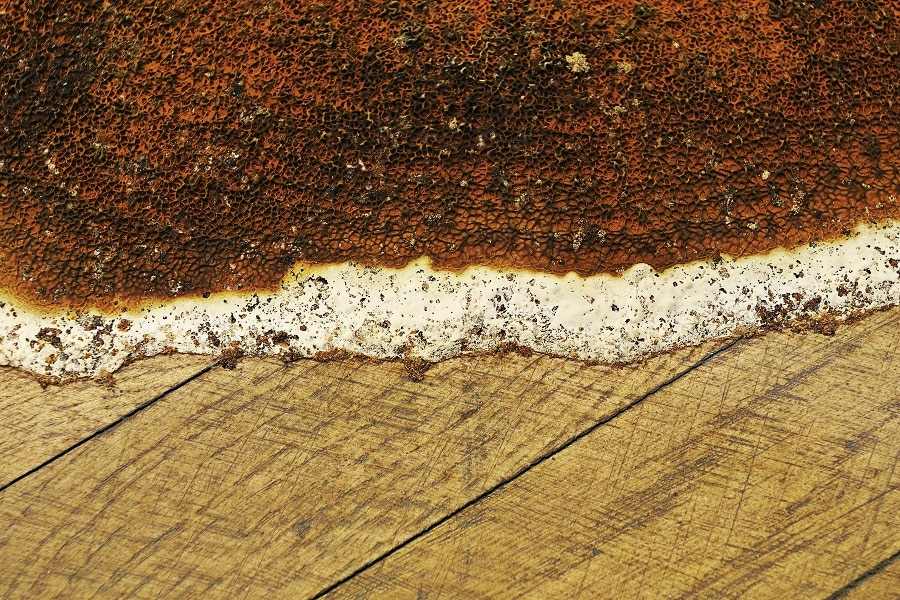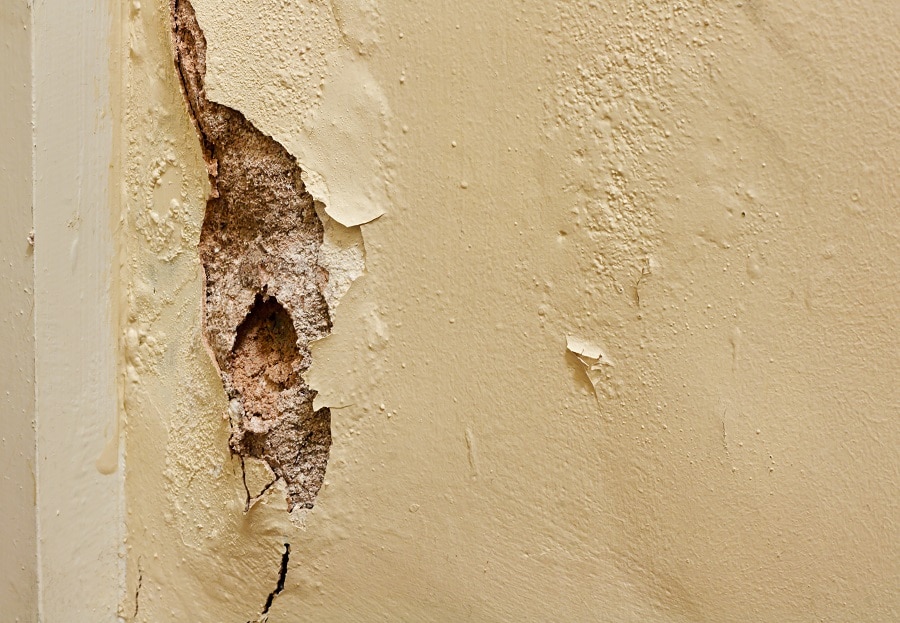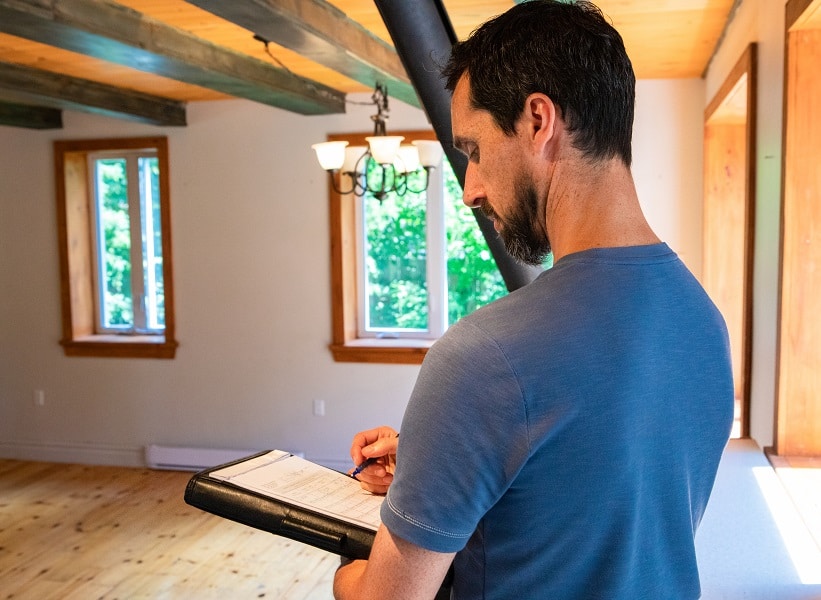What is dry rot?
Dry rot is a common term for various kinds of wood-decay fungus. Wood is broken down by Sporocarp (fungi), as the Mycelium consumes the wood, dry rot occurs resulting in fine dust particles, decomposition of the wood and dry rot bloom. Dry rot fungal spores need an adequate place to land and begin their colonies before they disperse through the underlying wood. Many of these spores can be found in soil and old wood already affected by dry rot.
This ensures that even treated wood will be re-infected with dry rot if it is wet enough (i.e., below 15 percent relative humidity). Dry Rot causes significantly greater damage than Wet rot, you may be shocked to hear that dry rot fungus can attack the structural timber in your property whilst remaining undetected. It often occurs where you’re not looking. It could be under the plaster, beneath your floorboards, or even in your loft. This is why it’s essential to know the signs and symptoms of dry rot and to get it treated quickly.
Our Guarantee
- upto 30 year guarantee
- customer focused team
- 20 years combined experience
- portfolio of satified customers
- attention to detail
- Construction line accreditation
- public liability insurance
- CHAS accreditation
What is the difference between dry rot and wet rot?
Dry rot and wet rot are two different kinds of fungus that can destroy wood if left untreated. One of the biggest differences is that dry wood requires significantly less moisture to harbor the activity that leads to rot. Contrarily, dry rot does not spread as easily as wet rot. This is so because Dry Rot fungus thrives even in eco-friendly woods like bamboo and uses the capillaries within the timber to grow. Dry rot is extremely destructive and spreads quickly through a house, even retaining its ruinous effects if the room has been previously treated for damp or wet rot. On the other hand, wet fungus occurs when timber becomes wet for long periods of time.
Call Our Sussex Damp Experts team now for quote, consultation and advice:
Call on 01273 257 765.
What are the causes of dry rot?
Many species of fungi cause dry rot. The most commonly found in the Heathfield is Serpula Lacrymans. it can spread from your home’s walls to the floors, and even the plaster is not fixed soon enough. This would damage the integrity of your structural wood, and thus the structural integrity of your whole residence. Dry rot can develop if you don’t keep the amount of moisture in your timber balanced. This will attract the fungus that will then provide nutrients. “Dry rot” is used to distinguish “wet wood” from “dry wood rot.”
Wet timber fodder on a dry rot. Those spores are dry, and those hyphae only need 20% dampness to grow into fungi while fungal spores require above 30% wet to generate hyphae. These cells can grow into a fungal body called a mycelium, which also spreads outward to find more wood in stone and brick. H2O, Hemicellulose and cellulose can be stripped from the timber by this fungus, leaving behind a fragile structure of the original wood. You will require an expert survey to see if the rotting wood is affected by dry rot or by another fungus. It’s important to note that not all treatments will work for every case of nicotine damage.

The dangers of dry rot in Heathfield
Dry Rot Effect on your Property
The greatest issue with dry rot is that it can easily attack the structural integrity of your house. It will spread along the structural timbers inside your property and begin to break them down. Extreme conditions may cause your home or appliances to fail. It won’t attack the mortar between your bricks or stones, but it can travel through it. This is why regular checks are important.
Dry Rot can cause extensive damage, and it is vital that you get to it as soon as possible. When fungus manifests, you should call a Dry Rot Expert immediately to avoid an infestation and deal with the occurring damage quickly. If you think you might have a problem with dry rot, get a survey from Sussex Damp Experts today.
Dry Rot Effect on Your personal health
It is not the fungus that causes dry rot that is harmful. The existence of dry rot can cause a number of health problems. If you suffer from respiratory problems, asthma or allergies and don’t have a smoke alarm, then this guide is for you.
What are the Warning Signs of Dry Rot?
Discovering dry rot early is essential to preventing devastating and costly damage. A full assessment is recommended if you experience any of the following signs/symptoms.
-
The beginning of the dry rot cycle
Fungi spores may travel through air via wind in order to infect a new host. They only need a small place to come inside and will slowly but surely chew holes through the wood. The fungus then hyphae will germinate and start to spread through the timber if the wood gives them enough nutrients. Spider web-looking collections called mycelium will join up as the hyphae grow and feed. Mycelium can be light grey to pure white. They can even work their way into your property’s foundations and spread into the mortar, bricks and plaster to find new timber.
-
Your timber is damaged.
You will see that the core of your timber has become soft and dry. Your timber may collapse as a result of this. You may observe the dry rot changing the color of your timber. Cuboidal cracking on walls can be caused by a multitude of dry rot. Cuboidal cracking is when timber breaks up into cubes that are around 50 mm in width. The fungal deterioration will also spread further into the wood, causing hyphae the white fungal growth. Hyphae are spider-like fungal growth, they look like cobwebs and are a common symptom of dry rot.
-
Your timber will smell.
If you smell a strong, fungal, dank and musty odour in your timber, it is likely to be affected by dry rot. This can happen even if you can’t see the outbreak of dry rot. The smell of mold, however, is not a definite indicator that there are no signs of dry rot.
-
Your timber will have fungus bodies on it.
It has likely entered the final stage of dry rot and the most obvious. Those cute little mushroom-like fruiting bodies can start joining themselves with your wood. If it becomes dry, dry rot can no longer feed on the wood so it will pop out spores instead.
-
Your timber will have spore dust.
Dry rot does not just occur in timber that is already affected. If you are seeing splotches of rusty coloured dust accompanying decomposed spores, it could be a sign of dry rot. Fertile bodies supply this spore dust in the final cycle of dry rot.
Dry Rot Treatment in Heathfield

Not until when the moisture level is above 20% will a dry rot invasion occur. Controlling moisture levels in your living space/property is the first preventative step to eradicating the presence of the fungus. You are now in charge of the moisture levels. For your dry rot treatment, meet a professional.
Sussex Damp Experts can help you with the removal of infected timber and any remedial work. Infected timber removal is the work of a professional. The exact treatment is known by a professional damp proofing expert. Some treatments are injected into the timber, others coat the surface of the timber. There are also several preventative treatment options available. These chemicals require specific concentrations and can have unpleasant side effects if inhaled or injected accidentally.
An expert can insert into your timber Boron rods. Boron is a hazardous mineral, so it is important to wear protective clothing whilst damp proofing your basement. Through our damp proofing expert team, we will be able to identify some dry rot problems and determine the seriousness of the problem. Dry rots can lead to serious complications if left untreated for a long time. If left untreated, dry rot can expand and cause great damage. Our team at Sussex Damp Experts will implement a suitable treatment that addresses your problem efficiently and cost-effectively. Please don’t be late Call today 01273 257 765, for a free survey, and effective treatment of dry rot.
How can you prevent dry rot damage in Heathfield?
The first step in treatment is to avoid dry rot. Most typically, a rot invasion occurs near an area that has a high amount of moisture and where the wood has enough space to dry and shrink. Any activities that prohibit them from evolving are present here: Make sure there are no leaks in your house. Make available sufficient ventilation.
Properly ventilate and insulate your attic. Oxygenate crawlspaces very well. Waterproof the exterior of your home by sealing the basement and crawlspace floors with our durable, waterproof sealers. Check all flickering walls and roofs to ensure that the water is adequately directed. Keep the sinks and downs clear. Using a wet system? Check for plumbing and heating leaks in your home. Because of the moist conditions required for dry rot fungus to feed and germinates, the best way to reduce the risk of dry rot is to minimize moisture levels. You can help prevent water damage by plugging the leak.
Speak to a Dry Rot specialist in Heathfield
We are equipped to deal with any damp proofing or dry rot problems affecting your property or home. We’ll do a full steam survey of the property and give you a free estimation before we start any work. Over the years, with their damp concerns, we have helped thousands of Heathfield homeowners, and we will support you too. Contact us on 01273 257 765 for a free quote and survey. An expert in dry rot removal will assess your problem quickly and accurately. We will always give you our best and impartial advice on treatment that is right for your needs.

We have a complete list of expert surveyors who carry out all types of surveys and assessments, from pre-purchase surveys to full structural repairs. Dry rot gets worse over time by its nature, it is important to contact us immediately if you think you have a problem. Sussex Damp Experts will be able to help you no matter what the nature of your damp issue is, email or call us on 01273 257 765
FAQ
Should dry rot be restored or replaced?
A certain level of dry rot can be repaired, but whether the damaged areas provide the house with structural stability, such as beams and joints, or even flooring, it is not recommended. Replace the wood in such a situation instead of repairing it. Whether you restore or rebuild the wood, it is better if you avoided the conditions that caused the rot to flourish in the first place or risked it coming back. Your roof leaks, broken gutters, or downspouts, plumbing leaks or insufficient ventilation should be inspected when considering a roof moisture accumulation You may consult a specialist to find and repair the problem.
Will you be able to treat my Dry Rot problem effectively?
With our expertly trained surveyors and specialists, a dry rot problem can be treated, rectified, and your timber can be protected for the future.
How do I discover how far Dry Rot has spread?
If you have traced the dry rot fungus quickly or not, a professional will identify the source of the problem. They will be able to trace the fungus in the different masonry and plaster from which it has spread.
How much can dry rot widen?
Dry rot spores can spread in anyplace with the right environmental settings. The reason is that they are carried in the atmosphere. If your timber has a moisture content of around 20%, and if it is in the open air, these conditions are attractive to dry rot fungus. This suggests that fungus groups can disperse to multiple materials. If dry rot is spreading across masonry and plaster, and if it reaches more timber to feed off where the timber is moist. It can widen further. Dry rot fungus needs five things to survive: the right temperature, drive rot spores, moisture, oxygen, and the food source. In any home in Brighton most of this is present.
Will dry rot stretch?
What should I do to control dry rot?
First identify the reason for your timber moist before solving it. A different treatment shall be given if the reason for your timber moisture is outside.
What are the effects of living dry rot unchecked?
Dry rot is the most insidious form of moisture that can infest property and cause permanent damage to the building if left untreated. Sometimes, once the harm is already done due to the places in which the problem is likely to be the presence of dry rot does not come to light.
Is dry rot stringent?
Dry rot can be particularly common in wooden properties, so it is essential that early signs of dry rot are identified before the damage becomes too severe.
How am I meant to know if I have dry rot?
A timber survey will assess how your timber is affected by being exposed to moisture. Later on, fruiting bodies and mycelium will be noticeable in the drive rot life-cycle.
Where can dry rot grow?
Dry rot attacks and rots timber that’s been in contact with water for a long period of time. Although it can often be mistaken for other problems in its early stages, it is important to seek advice. In every structure, both old and new, dry rot can grow. The reason being that it is caused by moisture and wetness that happen anyplace. Dry rot can be caused by leaks or weather, meaning the type of property does not affect it.




